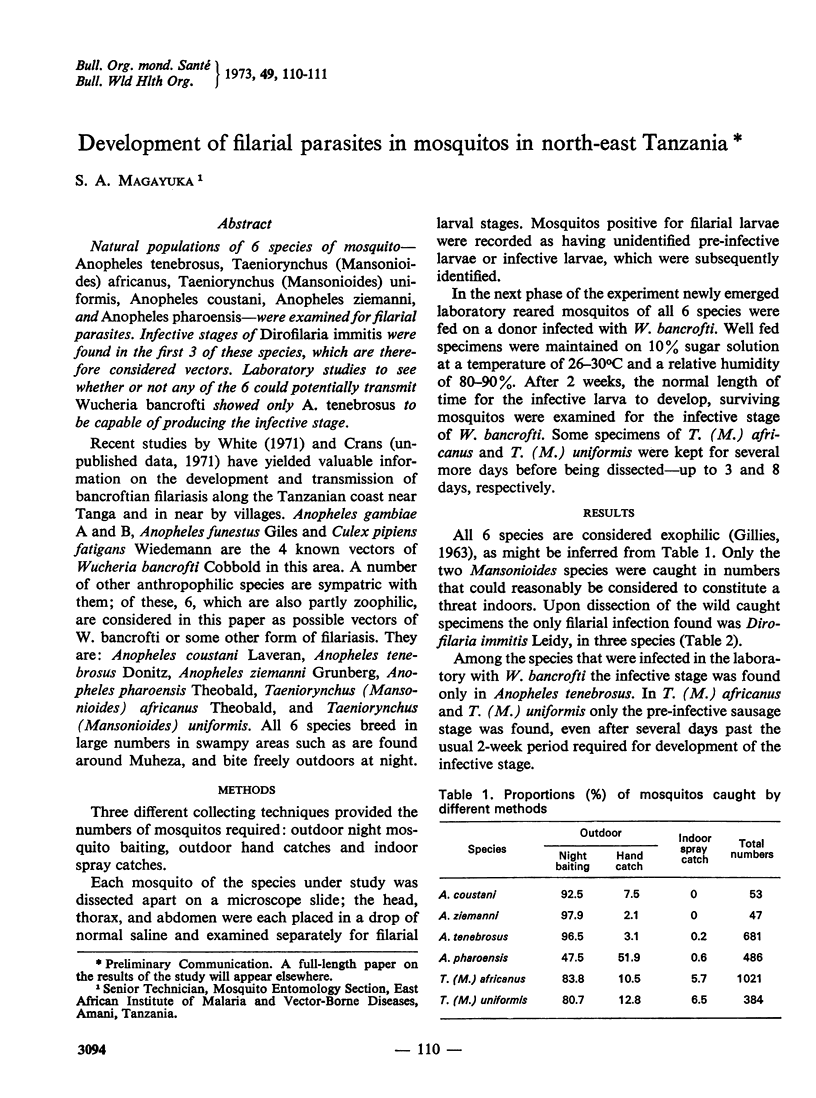Abstract
Natural populations of 6 species of mosquito—Anopheles tenebrosus, Taeniorynchus (Mansonioides) africanus, Taeniorynchus (Mansonioides) uniformis, Anopheles coustani, Anopheles ziemanni, and Anopheles pharoensis—were examined for filarial parasites. Infective stages of Dirofilaria immitis were found in the first 3 of these species, which are therefore considered vectors. Laboratory studies to see whether or not any of the 6 could potentially transmit Wucheria bancrofti showed only A. tenebrosus to be capable of producing the infective stage.
Full text
PDF

Selected References
These references are in PubMed. This may not be the complete list of references from this article.
- ABADIE S. H., SWARTZWELDER J. C., HOLMAN R. L. A HUMAN CASE OF DIROFILARIA IMMITIS INFECTION. Am J Trop Med Hyg. 1965 Jan;14:117–118. doi: 10.4269/ajtmh.1965.14.117. [DOI] [PubMed] [Google Scholar]
- Beaver P. C., Orihel T. C. Human infection with filariae of animals in the United States. Am J Trop Med Hyg. 1965 Nov;14(6):1010–1029. doi: 10.4269/ajtmh.1965.14.1010. [DOI] [PubMed] [Google Scholar]
- Bianchi L., Caprioglio A. Dirofilariasi sottocutanea nell'uomo. Sei casi autoctoni della pianura padana. G Mal Infett Parassit. 1972 Feb;24(2):98–104. [PubMed] [Google Scholar]
- GILLIES M. T. OBSERVATIONS ON NULLIPAROUS AND PAROUS RATES IN SOME COMMON EAST AFRICAN MOSQUITOES. Ann Trop Med Parasitol. 1963 Dec;57:435–442. doi: 10.1080/00034983.1963.11686197. [DOI] [PubMed] [Google Scholar]
- HEISCH R. B., NELSON G. S., FURLONG M. Studies in filariasis in East Africa. 1. Filariasis on the Island of Pate, Kenya. Trans R Soc Trop Med Hyg. 1959 Jan;53(1):41–53. doi: 10.1016/0035-9203(59)90082-3. [DOI] [PubMed] [Google Scholar]
- NELSON G. S., HEISCH R. B., FURLONG M. Studies in filariasis in East Africa. II. Filarial infections in man, animals and mosquitoes on the Kenya Coast. Trans R Soc Trop Med Hyg. 1962 May;56:202–217. doi: 10.1016/0035-9203(62)90155-4. [DOI] [PubMed] [Google Scholar]
- NISHIMURA T., KONDO K., SHOHO C. HUMAN INFECTION WITH A SUBCUTANEOUS DIROFILARIA IMMITIS. Biken J. 1964 Apr;7:1–8. [PubMed] [Google Scholar]
- Tannehill A. W., Jr, Hatch H. B., Jr Coin lesions of the lung due to Dirofilaria immitis. Report of a case. Dis Chest. 1968 Mar;53(3):369–371. doi: 10.1378/chest.53.3.369. [DOI] [PubMed] [Google Scholar]
- White G. B. Studies on transmission of Bancroftian filariasis in North-Eastern Tanzania. Trans R Soc Trop Med Hyg. 1971;65(6):819–829. doi: 10.1016/0035-9203(71)90098-8. [DOI] [PubMed] [Google Scholar]
- Yoshimura H., Yokogawa M. Dirofilaria causing infarct in human lung. Am J Trop Med Hyg. 1970 Jan;19(1):63–67. doi: 10.4269/ajtmh.1970.19.63. [DOI] [PubMed] [Google Scholar]


